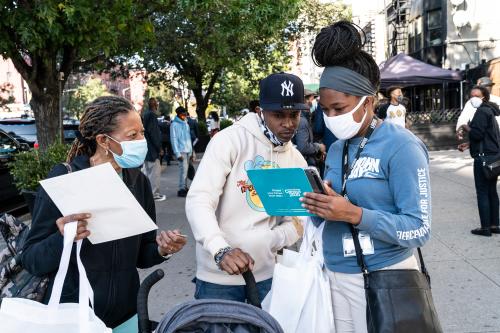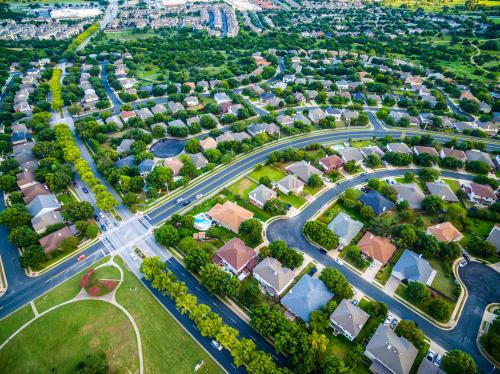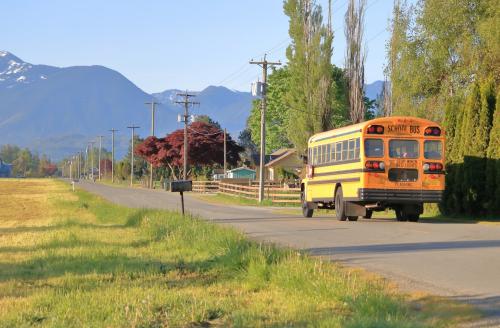Joe Biden is stepping into his role as the nation’s 46th president with a contentious political environment and a deeply divided electorate. Some of Biden’s detractors point to his razor-thin wins over Donald Trump in several battleground states as evidence that his November victory was far from dominant, despite the fact that Biden won the popular vote by a margin exceeding 7 million, among 159 million votes cast.
Another way of looking at Biden’s victory is to focus on the total populations residing in the counties that Biden and Trump won. From that perspective, 67 million more people lived in counties won by Biden (197.9 million) than in those won by Trump (130.3 million). This is the largest difference in two major presidential candidate’s county-won populations since 1996, when Bill Clinton bested Bob Dole.

It is important to note that the total population in these counties includes nonvoters, such as children, noncitizens, and others who did not vote in November. Nonetheless, these residents still reflect the communities in which they live. Thus, a further examination of who lives in Biden and Trump counties should provide a deeper understanding of how different groups of these populations are spread across so-called “blue” and “red” America.
Biden populations are located primarily in large cities and suburbs
Much has been made of the urban-rural divide in American politics. However, it has been shown that it was actually the suburban vote that shifted the balance in favor of Biden. Even more instructive are the population sizes of Biden- and Trump-won counties, classed by urban status categories developed by the Brookings Institution.

Large urban core counties (counties with high population densities) account for nearly half the population (97 million people) among all counties that voted for Biden. Suburban counties in large metropolitan areas accounted for an additional 72 million people in Biden-won counties.
In contrast, Trump-won county populations were only modestly represented in large urban cores, accounting for 4.7 million people. The vast majority of Trump county populations were distributed among large suburban counties, small metropolitan areas, and nonmetropolitan areas.
Because small metropolitan and nonmetropolitan counties are far less populous than large metropolitan areas, there are many more Trump-won counties than Biden-won counties (2,588 versus 551). Thus, a look at any national map of the 2020 voting results shows seas of red counties surrounding clusters of blue ones. Yet the reason that Biden counties house 67 million more people than Trump counties lies with the fact that the former dominate large urban core and suburban counties in major metropolitan areas.
Growing demographic groups reside mostly in Biden counties
Calculated as a share of the national population, 60% of U.S. residents live in Biden counties. Yet this share varies widely across demographic groups, with Biden counties most likely to be home to growing groups and those with “urban” attributes in terms of race-ethnicity, education, foreign-born status, and even marital status.

Among race-ethnic groups, significant shares of the nation’s people of color live in Biden counties. Roughly three-quarters of the U.S. Black and Latino or Hispanic populations live there, as do 86% of Asian Americans and nearly two-thirds of persons identifying as two or more races. In contrast, only half of the nation’s white population resides in Biden counties.
Distinct among that white population are white college graduates, of whom nearly two-thirds live in Biden counties. All other white population groups without a college education are more likely to live in Trump counties. This is especially true for whites with high school educations or less.
Two other demographic attributes that sharply contrast across Biden and Trump counties are nativity and marital status. More than four-fifths of foreign-born U.S. residents reside in Biden counties, compared to less than three-fifths of native-born Americans who do. Similarly, single people are more likely to live in Biden counties than those that are currently married.
When looking at households classed by income, a majority of those in all income categories reside in Biden counties. But the difference is widest for those with the highest incomes; over two-thirds of households earning at least $150,000 per year reside in Biden counties, compared with just over half of those earning less than $50,000.
Biden counties are younger and more racially diverse
The diverging profiles of Biden’s America and Trump’s America might best be compared when looking at the age and racial makeup of each candidate’s counties. In keeping with the urban-rural divide discussed above, Trump’s America is clearly whiter and older. Even young people living in Trump counties are predominantly white—despite the fact that, nationally, the under-age-16 population is minority white.

Populations in counties where Biden prevailed are younger and decidedly more diverse. There, as a group, minorities outnumber whites for all ages under 45, and are not far behind whites in the 45-to-54 age group.
What these divisions imply for the future
These statistics make plain that the U.S. is deeply divided by demographics and politics. But Biden’s win in counties that house a decided majority of the U.S. population bodes well for the Democrats in future presidential election years, especially because the “urban” demographic groups that disproportionately live in these counties—people of color, college graduates, the foreign-born, and unmarried persons—represent growing segments of the population.
It is possible that the still substantial part of the population that is heavily represented in Trump counties—rural and small-town residents, older Americans, and whites without college educations— could keep Republicans competitive if the post-Trump party is able to hold on to this base. But it may not be a viable long-term strategy for them if recent projections hold true.
In many ways, the nation stands at the precipice of a demographically rooted political divide that has been sharpened in ways that are not healthy for our democracy. Let’s hope that President Biden can become the “healer-in-chief” that America now so desperately needs.
The Brookings Institution is committed to quality, independence, and impact.
We are supported by a diverse array of funders. In line with our values and policies, each Brookings publication represents the sole views of its author(s).






Commentary
Biden-won counties are home to 67 million more Americans than Trump-won counties
January 21, 2021